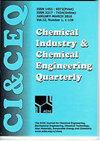Application of the model of cylindrical reactor for self-purification by indigenous microorganisms
IF 0.8
4区 工程技术
Q4 CHEMISTRY, APPLIED
Chemical Industry & Chemical Engineering Quarterly
Pub Date : 2021-01-01
DOI:10.2298/CICEQ201126006R
引用次数: 0
Abstract
Pharmaceutically Active Compounds (PhACs), in particular, Nonsteroidal anti-inflammatory drugs (NSAIDs) are in increasingly wider usage, and as such are more and more frequently part of the organic matter of recipient rivers, especially in their lower course. To indicate their significance as pollutants, as well as the significant role that the presence of autochthonous microflora plays in solving this issue, we undertook to perform this experiment. The experiment, titled ?Application of the Model of Cylindrical Reactor In Self-purification by Indigenous Microorganisms?, was conducted during one year period at the location of Vukovci, in the lower course of Moraca river. Assuming that the concentration of NSAIDs and PhACs in water can be reduced through self-purification, it has been proven that such processes result in a modification of phenotype in the indigenous microbiological population. Having the abovementioned premise in mind, we constructed the experiment model, which entails kineticism of water, whereas the defined volume flow rate per unit time was 0.005 m/s; through the known distance of 432 m. Over one year of application of the model of the cylindrical reactor for enhancing self-purification capacity by indigenous microorganisms, auto-purification increased by 28.05%, the phenotype of the indigenous microorganisms changed by 24.62%, whereas the total concentration of particular PhACs, micropollutants, and NSAIDs decreased by 4.19%.圆柱形反应器模型在原生微生物自净化中的应用
药物活性化合物(PhACs),特别是非甾体抗炎药(NSAIDs)的应用越来越广泛,因此越来越多地成为受体河流有机物的一部分,特别是在其下游。为了表明它们作为污染物的重要性,以及本地微生物群的存在在解决这一问题方面所起的重要作用,我们进行了这项实验。实验题目为“圆柱形反应器模型在原生微生物自净化中的应用”。在莫拉卡河下游的Vukovci地点进行了为期一年的调查。假设nsaid和PhACs在水中的浓度可以通过自净化来降低,已经证明这种过程会导致本地微生物种群表型的改变。考虑到上述前提,我们构建了实验模型,该模型考虑了水的运动学,定义单位时间体积流量为0.005 m/s;通过432米的已知距离。采用圆柱反应器模型提高微生物自净能力1年后,自净能力提高28.05%,微生物表型变化24.62%,而特定PhACs、微污染物和非甾体抗炎药总浓度下降4.19%。
本文章由计算机程序翻译,如有差异,请以英文原文为准。
求助全文
约1分钟内获得全文
求助全文
来源期刊

Chemical Industry & Chemical Engineering Quarterly
CHEMISTRY, APPLIED-ENGINEERING, CHEMICAL
CiteScore
2.10
自引率
0.00%
发文量
24
审稿时长
3.3 months
期刊介绍:
The Journal invites contributions to the following two main areas:
• Applied Chemistry dealing with the application of basic chemical sciences to industry
• Chemical Engineering dealing with the chemical and biochemical conversion of raw materials into different products as well as the design and operation of plants and equipment.
The Journal welcomes contributions focused on:
Chemical and Biochemical Engineering [...]
Process Systems Engineering[...]
Environmental Chemical and Process Engineering[...]
Materials Synthesis and Processing[...]
Food and Bioproducts Processing[...]
Process Technology[...]
 求助内容:
求助内容: 应助结果提醒方式:
应助结果提醒方式:


